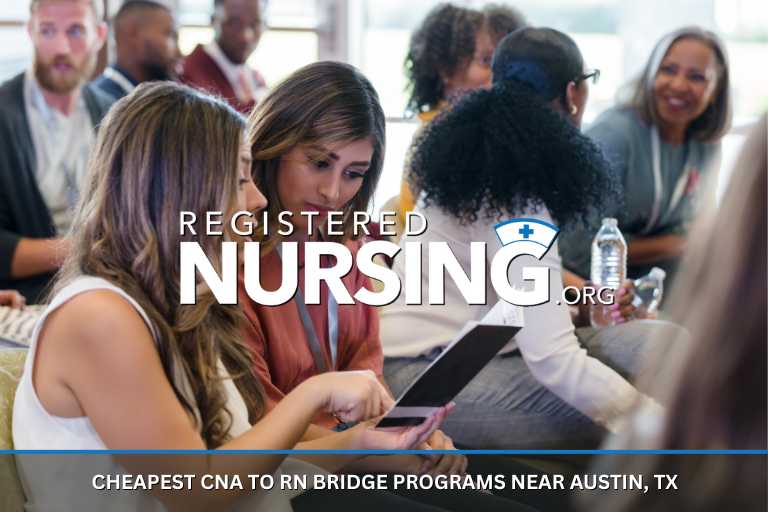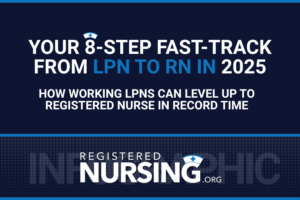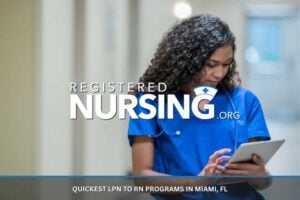Cheapest CNA to RN Bridge Programs near Austin, TX
- 2025 Top Budget-Friendly CNA to RN Bridge Programs Near Austin
- Why Consider a CNA to RN Bridge Program?
- What to Look for in an Affordable Program
- Additional Considerations for CNA to RN Students in Austin
- How to Apply and What to Expect
- Making the Most of a Bridge Program
- Planning Ahead for RN Success
- Sources
- Latest Articles & Guides

Austin, Texas continues to attract aspiring nurses thanks to its growing healthcare sector, vibrant culture, and educational opportunities. As demand for skilled RNs rises in Central Texas, certified nursing assistants (CNAs) in the region are increasingly pursuing bridge programs to become registered nurses. According to the Texas Center for Nursing Workforce Studies, the state will face a shortage of more than 57,000 RNs by 2032. This projected gap presents both a professional opportunity and a financial incentive to advance within the nursing profession.
In the heart of the Lone Star State, Austin offers several affordable CNA to RN bridge programs designed to accommodate working adults. These programs not only cost less than traditional routes but also provide flexibility through part-time, evening, and hybrid options. The city is known for its innovation in healthcare and proximity to major medical centers like St. David’s Medical Center and Ascension Seton Medical Center. With scenic greenbelts, a thriving music scene, and job growth outpacing the national average, Austin presents an appealing backdrop for academic and career advancement in nursing. Whether interested in working in critical care, community health, or outpatient clinics, CNAs in Austin have access to a wide range of training and employment pathways that support long-term growth.
2025 Top Budget-Friendly CNA to RN Bridge Programs Near Austin
Why Consider a CNA to RN Bridge Program?
CNA to RN bridge programs offer a fast and focused path for certified nursing assistants seeking upward mobility in the healthcare field. These programs build on existing knowledge and clinical experience, offering advanced placement opportunities that can significantly shorten the time needed to become a licensed RN. With demand rising across hospital systems and outpatient facilities, bridge programs are increasingly recognized as a smart and efficient stepping stone to a higher-paying and more autonomous nursing role.
Key Benefits:
These advantages make CNA to RN bridge programs especially appealing for healthcare workers looking to expand their scope of practice without stepping away from the workforce.
- Accelerated Timeline: Many CNA to RN programs take just 18 to 24 months.
- Cost Savings: Tuition is generally lower than traditional four-year degrees.
- Flexible Formats: Evening, weekend, and hybrid classes accommodate working CNAs.
- Increased Earning Potential: RNs in Austin earn an average salary of $80,000 compared to roughly $34,000 for CNAs, according to the Bureau of Labor Statistics.
- Greater Responsibility and Autonomy: Registered nurses can perform assessments, administer medications, and manage patient care plans—responsibilities beyond the CNA scope.
What to Look for in an Affordable Program
Affordability is about more than just low tuition. When evaluating CNA to RN bridge programs near Austin, it is essential to consider several cost-related and educational quality factors. The right combination of financial support, strong clinical partnerships, and positive student outcomes can make all the difference.
- In-district vs. out-of-district tuition rates
- Availability of financial aid or scholarships
- Pass rates for NCLEX-RN licensing exams
- Clinical rotation partnerships with local healthcare providers
- Student support services, including tutoring and mentoring
Programs with strong clinical affiliations in Austin may offer easier access to local employment and hands-on training at high-ranking hospitals and community health facilities. Additionally, programs with flexible scheduling and online coursework can help students continue working while earning a degree.
Additional Considerations for CNA to RN Students in Austin
Austin-based CNAs seeking RN licensure can take advantage of local support resources to lower costs and improve success outcomes. From academic tutoring to transportation assistance, support services can play a critical role in helping students stay on track.
Cost-Saving Resources:
Several financial resources and funding options are available in Austin to help reduce the overall cost of CNA to RN programs. Many students qualify for state grants, institutional scholarships, or need-based aid.
- Texas Workforce Commission grants
- Employer tuition reimbursement (available through healthcare systems like St. David's or Seton)
- Free tutoring and NCLEX prep through local colleges
- State tuition waivers for eligible veterans and dependents
High-Value Support Services:
Support services offered by local programs can make a significant difference in student success and work-life balance. These resources help bridge the gap between academic responsibilities and personal obligations, enabling students to maintain momentum throughout their training. Access to these services often correlates with improved graduation and licensure rates.
- Academic advising
- On-campus child care
- Career services and job placement assistance
- Transportation assistance and flexible scheduling
- Peer mentoring and academic workshops
Local Job Outlook:
Austin's rapidly growing population and aging demographic continue to drive demand for healthcare workers. Registered nurses are especially needed at major facilities such as:
- Dell Seton Medical Center
- Ascension Seton Medical Center Austin
- St. David's HealthCare
- Baylor Scott & White Clinic – Austin Region
These employers frequently offer hiring incentives, loan repayment programs, and career advancement pathways for local RN graduates. With Austin ranking among the fastest-growing metropolitan areas in the U.S., healthcare organizations are expanding their workforce pipelines and seeking graduates from trusted local programs.
How to Apply and What to Expect
Admission into a CNA to RN program involves meeting both academic and professional prerequisites. Prospective students should be prepared to submit documentation and test scores within clearly defined application windows. Strong candidates often begin preparing several months in advance to ensure eligibility.
Common requirements include:
- Active CNA certification
- Completion of prerequisite courses (e.g., anatomy, microbiology)
- TEAS or HESI exam scores
- Immunization records and background check
- Letters of recommendation or personal statement (at some schools)
The application timeline may span several months. Applicants are encouraged to consult program-specific admissions counselors early in the process to ensure timely completion. Attending an information session or open house can also provide insights into faculty expectations, curriculum structure, and available resources.
Making the Most of a Bridge Program
Success in a bridge program requires strategic planning and active engagement. Students should consider forming study groups, participating in simulation labs, and utilizing faculty office hours. Staying organized with a weekly calendar and setting aside time for review sessions can be especially helpful during intensive clinical rotations. Attending local networking events through organizations like the Texas Nurses Association – District 5 can further enhance career prospects.
Graduates who build strong relationships during clinical rotations often receive job offers before completing their program. Seeking guidance from academic mentors and career counselors can also lead to internship opportunities and valuable connections within Austin's nursing community.
Planning Ahead for RN Success
For CNAs in the Austin region, transitioning into an RN role through an affordable bridge program is both achievable and advantageous. Selecting the right program, utilizing available financial resources, and taking full advantage of Austin’s thriving healthcare network can result in a rewarding and sustainable career upgrade. By investing in professional development now, CNA professionals not only boost their earning power but also gain access to more fulfilling and impactful roles within the healthcare system.
Sources
- Bureau of Labor Statistics – Registered Nurses
- Texas Center for Nursing Workforce Studies
- Austin Community College – Student Tutoring Services
- Texas Nurses Association – District 5
Latest Articles & Guides
One of the keys to success as a registered nurse is embracing lifelong learning. Our articles and guides address hot topics and current events in nursing, from education to career mobility and beyond. No matter where you are on your nursing journey, there’s an article to help you build your knowledge base.
Browse our latest articles, curated specifically for modern nurses.



